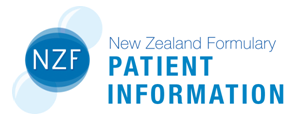What does it do?
Nitrofurantoin is an antibiotic used to treat and prevent urine infections, often called UTIs (urinary tract infections).
Before you start
- Tell your health professional if you have kidney or liver problems, or if you have G6PD deficiency.
- Tell your health professional if you are pregnant, planning to become pregnant, or breastfeeding.
How should you take it?
Take nitrofurantoin regularly as directed. Take it with food and with a glass of water. Keep taking it until the course is finished, even if you start to feel better.
Slow-release capsule: Swallow whole – do not crush or chew.
What if you forget a dose?
Take the missed dose as soon as possible and continue as directed.
Can you take other medicines?
Some medicines available without a prescription may react with nitrofurantoin including:
- magnesium trisilicate (e.g. Quick-Eze®)
Tell your pharmacist or doctor about all medicines or treatments that you may be taking, including vitamins, herbal products or recreational drugs.
What side effects might you notice?
| Side Effects | Recommended action |
|---|---|
|
Short of breath, persistent dry cough Symptoms of liver problems including: yellow skin or eyes, itching, dark urine, pale bowel motions, abdominal pain Numbness or tingling of the fingers or toes Symptoms of allergy including: skin rash, itching, swelling, trouble breathing Headache, changes in vision, pounding in one or both ears (may be intracranial hypertension) Severe stomach pain, nausea |
Tell your doctor immediately |
|
Stomach upset, loss of appetite |
Tell your doctor if troublesome |
|
Change in urine colour (dark yellow or brown) |
This is harmless |
If you notice any other effects, discuss them with your doctor or pharmacist.
Other information:
- Side effects such as lung problems are more likely if you take nitrofurantoin long-term to prevent infections. Check with your doctor how long you need it for. Tell your doctor if you develop a dry cough or shortness of breath.
This leaflet contains important, but not all, information about this medicine.
Prepared by the MyMedicines Committee at Christchurch Hospital, Te Whatu Ora - Waitaha, New Zealand. August 2023
For more general information about this sheet and its contents, see: What does a My Medicines sheet cover?
Te Reo Māori
Te Reo Māori information sheets supported by Health Quality and Safety Commission New Zealand
Web links for this sheet in different formats
Click on buttons to copy web addresses for this leaflet:
If your browser does not automatically copy these links use its copy command instead.
About My Medicines
My Medicines Patient Information Leaflets (PILs) contain important, but not all, information about the medicines they describe.
For more information about the sheets, see: What does a My Medicines sheet cover?
My Medicines is developed by a team at Te Whatu Ora – Waitaha. Our team is made up of doctors, pharmacists, and a non-medical person to help us keep to plain language. We also discuss our information with specialist health professionals or groups when needed

